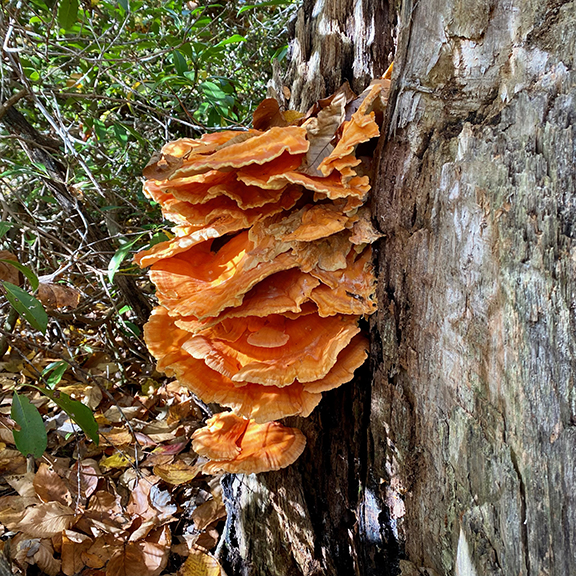
Finding Fall Fungi
This post, written by Gail Kahover, contains excerpts that originally appeared in an Avalonia eTrails blog entry by Beth Sullivan in 2021.
The green leaves of summer are turning into shades of yellows, browns, and reds. Alongside the fallen acorns and pretty leaves, you will find the mushrooms.
The fungi can be found in many shapes and colors, from the delicate chanterelles to the larger, beefy chicken of the woods. They can be found in your yard, after a rain, or in the woods on dead tree stumps in the late summer and early fall.
Did you realize that mushrooms are not plants, nor are they animals? Fungi are in a kingdom of their own. Beth Sullivan, who wrote Avalonia’s blog Avalonia eTrails for years, points out that mushrooms don’t have roots, a vascular system, flowers, or seeds. They contain no chlorophyll so they can’t make “food” by utilizing nutrients and sunlight. Instead, they rely on getting their nutrients from the decay process they are part of on the forest floor. The fungi absorb their food through this process, rather than eating it or making it, Beth explains.
“Mushrooms are actually the visible, spore-producing bodies of a largely underground network of rhizome threads that comprise a fungus,” she wrote. “The spread of the rhizomes extends great distances but only one or two mushrooms may emerge. In other cases, many will pop up in the same areas.”
Some mushrooms are very specific, Beth points out, dependent for their survival on certain species of living trees, dead trees, or in soil with very narrow ranges of pH, and soil acidity. The outer tough skin of many mushrooms is made of Chitin, which is the same material as the shells of lobsters and crabs, Beth writes.
So as you walk through the woods this fall, be sure to look down at the forest floor and see how many colors and shapes of mushrooms you can find. And remember, there are some mushrooms that are considered edible and many others that are inedible and even deadly. It’s best to capture them with a camera, rather than for your dinner table unless you know what you’re doing. As Beth writes: “Mushroom hunting for food is to be undertaken only by the knowledgeable. The rest of us can hunt with our cameras.”
If you do find some interesting mushrooms, please share your photos on Instagram. Use hashtag #myavalonia and tag @avalonialandconservancy

